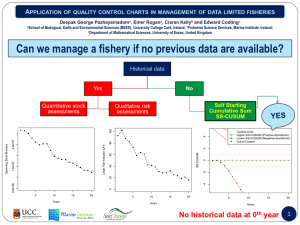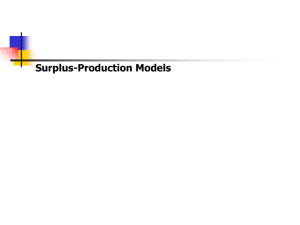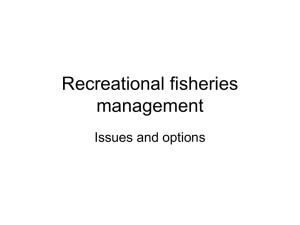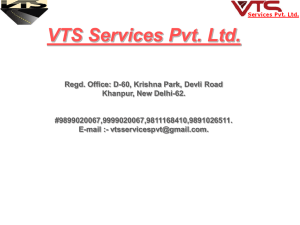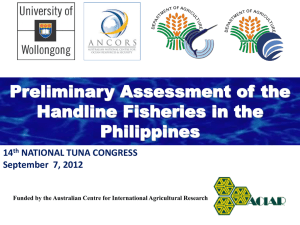Biostatistics 4
advertisement
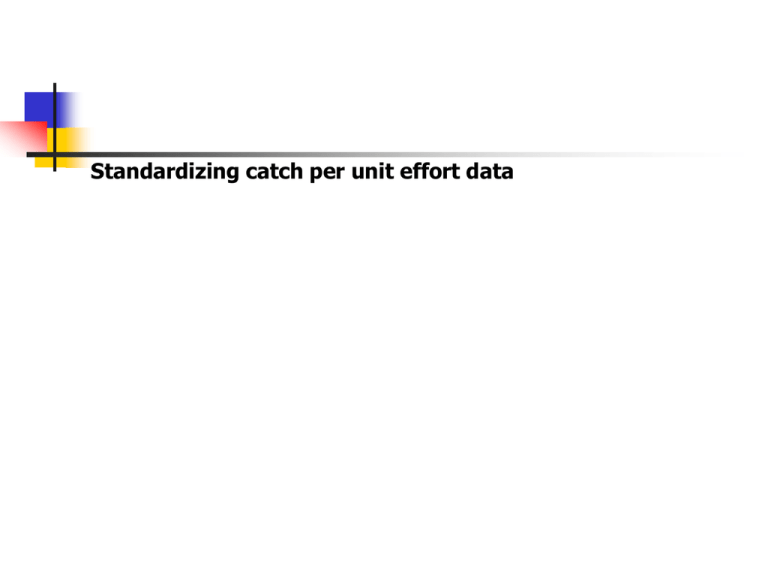
Standardizing catch per unit effort data Standardization of CPUE 2 Catch = catchability * Effort * Biomass CPUE = Catch/Effort = U = catchability * Biomass Ut = qBt Ut: Catch per unit effort at time t q : catchability of the whole fleet catchability: the proportion of the stock caught per one unit of effort In most fisheries we normally have fleets with different catchabilities Lets start by looking at a fishery on a stock where we have vessel types (i) that have different catchabilities: Ut ,i qi Bt Ut,i: Catch per unit effort of vessel type i at time t qi : catchability of vessel type i 3 A very simplified artificial case: 2 Fleets For illustration we create some CPUE data for 6 years for 2 fleets from known stock size, effort and catchability Catchability is fleet specific, with fleet 2 having 3 times higher catchability than fleet 1 Effort in Fleet 1 declines while it increases in fleet 2. Total effort remains constant i Fleet 1 Fleet 2 q 0.00015 0.00045 Fleet 1 Year 2001 2002 2003 2004 2005 2006 Ci,t qi Ei,t Bt Stock size 10000 12000 14000 16000 16000 16000 Effort Catch CPUE 400 600 1.50 370 666 1.80 340 714 2.10 310 744 2.40 280 672 2.40 250 600 2.40 Fleet 2 Effort 100 130 160 190 220 250 q1/q2 3 Fleet 1 & 2 combined Catch CPUE Effort Catch CPUE 450 4.50 500 1050 2.10 702 5.40 500 1368 2.74 1008 6.30 500 1722 3.44 1368 7.20 500 2112 4.22 1584 7.20 500 2256 4.51 1800 7.20 500 2400 4.80 4 Stock size and overall unstandardize CPUE CPUE Stock size 6.00 18000 16000 5.00 14000 4.00 12000 10000 3.00 8000 6000 2.00 4000 1.00 2000 0 2000 2002 2004 2006 2008 0.00 2000 2002 2004 2006 2008 5 Relative values lets standardize the overall CPUE series relative to that of the first year: Year 2001 2002 2003 2004 2005 2006 Stock size 10000 12000 14000 16000 16000 16000 Relative stock size 1.00 1.20 1.40 1.60 1.60 1.60 Overall Relative CPUE CPUE 2.10 1.00 2.74 1.30 3.44 1.64 4.22 2.01 4.51 2.15 4.80 2.29 it is obvious that ignoring the different catchabilities of fleet 1 and 2 would lead wrong conclusion about biomass development however, if we were to use either Fleet 1 OR 2 we would get accurate representation of the relative change in biomass CPUE from some “selected” fleet, which is assumed to be homogenous over time is often used in practice The problem is that the assumption of homogeneity is an assumption in real cases! Relative stock size and overall CPUE 6 Relative stock size CPUE 2.5 2.5 2.0 2.0 1.5 1.5 1.0 1.0 0.5 0.5 0.0 2000 2002 2004 2006 0.0 2008 2000 2002 2004 2006 2008 it is obvious that ignoring the different catchabilities of fleet 1 and 2 would lead wrong conclusion about biomass development when using the 7 Standardizing the catch rate of each fleet lets standardized the CPUE series of each fleet relative to the first year: CPUE Year 2001 2002 2003 2004 2005 2006 Stock size 10000 12000 14000 16000 16000 16000 Fleet 1 1.50 1.80 2.10 2.40 2.40 2.40 Fleet 2 4.50 5.40 6.30 7.20 7.20 7.20 Relative CPUE Total 2.10 2.74 3.44 4.22 4.51 4.80 Fleet 1 1.00 1.20 1.40 1.60 1.60 1.60 Fleet 2 Total 1.00 1.00 1.20 1.30 1.40 1.64 1.60 2.01 1.60 2.15 1.60 2.29 if we were to use either Fleet 1 OR 2 we would get accurate representation of the relative change in biomass CPUE from some “selected” fleet, which is assumed to be homogenous over time are often used in practice Relative stock size and CPUE from Fleet 1 and 2 8 Relative stock size 2.5 2.50 2.0 2.00 1.5 1.50 1.0 1.00 0.5 0.50 0.0 2000 0.00 2000 2002 2004 2006 2008 Fleet 1 Fleet 2 Total 2002 2004 2006 2008 General linear modeling of CPUE data – the math 9 Relative changes in biomass: Lets first describe changes in biomass relative to the first year in the data series: Bt at B1 Bt – biomass at time t B1 – biomass in year 1 at – scaling factor where: a t Bt B1 and hence Time (year) 1991 1992 1993 1994 1995 1996 1997 1998 1999 2000 2001 2002 2003 2004 2005 Bt 300 290 280 270 260 250 240 260 280 300 320 340 360 380 400 a1 = 1.00 The aim is to use the at parameter in the relationship Ut = qBt at 1.00 0.97 0.93 0.90 0.87 0.83 0.80 0.87 0.93 1.00 1.07 1.13 1.20 1.27 1.33 Biomass (Bt) and relative biomass (at) 450 1.4 400 1.2 1.0 300 0.8 250 Bt alpha t 200 150 0.6 0.4 100 0.2 50 Year 2005 2004 2003 2002 2001 2000 1999 1998 1997 1996 1995 1994 1993 1992 0.0 1991 0 Relative biomass 350 Biomass 10 General linear modeling of CPUE data – the math 11 We have Bt at B1 , Ut qBt and U1 qB1 then U t qBt qa t B1 a t qB1 a tU1 Time (year) 1991 1992 1993 1994 1995 1996 1997 1998 1999 2000 2001 2002 2003 2004 2005 Ut 3.0 2.9 2.8 2.7 2.6 2.5 2.4 2.6 2.8 3.0 3.2 3.4 3.6 3.8 4.0 at 1.00 0.97 0.93 0.90 0.87 0.83 0.80 0.87 0.93 1.00 1.07 1.13 1.20 1.27 1.33 the a92, a93, a94, … are hence (again) a measure of biomass (B) relative to a91 = 1.00 but here we have related it to CPUE more importantly we gotten rid of the actual biomass (B)! General linear modeling of CPUE data – the math 12 The relationship: Ut atU1 only applies to homogenous fleet Lets revisit the imaginary 2 vessel class fisheries (where we “know” that q within a fleet has remained constant): U t ,1 q1 Bt Bt U t ,1 q1 U t , 2 q2 Bt q2 U t ,1 q1 q2 q1 U t ,1 q2 q1 a tU1,1 b 2|1 a tU1,1 Here the b2|1 is the efficiency of vessel class 2 relative to vessel class 1. The mathematical formula is effectively saying: the CPUE of vessel class 2 at any one time t is just a multiplier of CPUE of vessel class 1 at time t taking into account changes relative changes in biomass (at) since first year General linear modeling of CPUE data (4) 13 In general for multivessel fisheries we can write where Ut ,i at biU1,1 i: vessel size class i Ut,i : CPUE of the for time t and vessel class i U1,1: CPUE of the 1st vessel class in the 1st time period bi: The efficiency of vessel class i relative to vessel class 1 at: Relative abundance Food for thought: What is the value of at when t = 1? What is the value of bi when i = 1? General linear modeling of CPUE data (5) 14 To take into account measurement errors the statistical model becomes: Ut ,i at biU1,1e The error can be normalized by transformation: lnUt ,i lnat lnbi lnU1,1 t ,i We hence have a general linear model which can be used to estimate the parameters. For stock assessment purposed the parameters at is of most interest. However, one could consider that the bi parameters may be of interest in terms of understanding the fishery and for management What we have here is nothing more than: Yi = Ŷi + i … and we know how we estimates the parameters of such a simple model Food for thought: What is the value of ln(at) when t = 1? What is the value of ln(bi) when i = 1? General linear modeling of CPUE data (6) 15 The GLIM model fit is often done by rescaling all the cpue observation to that of U1,1 (as we have already done) I.e.: U t ,i a t b iU1,1e U t ,i U1,1 a t bie t ,i t ,i lnU t ,i U1,1 lna t ln(b t ) t ,i 16 Our example Lets first add some measurement noise (stochasticity) to our artificial deterministic CPUE data: U STO U DET e Fleet 1 Year Stock (t) size (Bt) 2001 10000 2002 12000 2003 14000 2004 16000 2005 16000 2006 16000 Year 2001 2002 2003 2004 2005 2006 Effort 400 370 340 310 280 250 Catch det CPUE sto CPUE 600 1.50 1.57 666 1.80 1.71 714 2.10 2.09 744 2.40 2.57 672 2.40 2.49 600 2.40 2.22 Fleet 2 Effort 100 130 160 190 220 250 Catch det CPUE sto CPUE 450 4.50 4.21 702 5.40 5.16 1008 6.30 6.30 1368 7.20 7.47 1584 7.20 7.05 1800 7.20 7.51 standardized CPUE relative to ln standardized CPUE relative U1,2001 to U1,2001 Fleet 1 Fleet 2 Fleet 1 Fleet 2 1.00 2.68 0.00 0.98 1.08 3.28 0.08 1.19 1.33 4.00 0.29 1.39 1.64 4.75 0.49 1.56 1.58 4.48 0.46 1.50 1.41 4.77 0.35 1.56 17 Spreadsheet schematics of the model for the simplified example lnUt ,i U1,1 lnat ln(bt ) t ,i Minimization SSE 0.0586 Parameters Name a2001 a2002 a2003 a2004 a2005 a2006 b1 b2 Just moving the parameter values here for clarity/convenience GLM model numeric 2001 2002 2003 2004 2005 2006 1 2 ln value 0.00 0.18 0.34 0.47 0.47 0.47 0.00 1.10 value 1.00 1.20 1.40 1.60 1.60 1.60 1.00 3.00 time (t) vessel (i) 2001 1 2002 1 2003 1 2004 1 2005 1 2006 1 2001 2 2002 2 2003 2 2004 2 2005 2 2006 2 observed ln cpue 0.00 0.08 0.29 0.49 0.46 0.35 0.98 1.19 1.39 1.56 1.50 1.56 ln(at) 0.00 0.18 0.34 0.47 0.47 0.47 0.00 0.18 0.34 0.47 0.47 0.47 ln(bi) 0.00 0.00 0.00 0.00 0.00 0.00 1.10 1.10 1.10 1.10 1.10 1.10 predicted ln cpue 0.00 0.18 0.34 0.47 0.47 0.47 1.10 1.28 1.44 1.57 1.57 1.57 2 obs-pre (obs-pre) 0.00 0.000 -0.10 0.010 -0.05 0.003 0.02 0.001 -0.01 0.000 -0.12 0.015 -0.12 0.013 -0.09 0.009 -0.05 0.002 -0.01 0.000 -0.07 0.005 -0.01 0.000 The ln-value for t=1 and i=1 is by definition zero The b value for the reference fleet i=1 is always zero, irrespective of the year (t) The a value for the reference fleet i=2 is the same as for i=1 within each year Best fit 20000 Biomass 18000 Minimized the squared residuals to obtain the best parameter estimates Minimization SSE 0.0197 1.6 14000 1.4 12000 1.2 10000 1.0 8000 0.8 6000 0.6 4000 0.4 2000 0.2 0 Parameters numeric 2001 2002 2003 2004 2005 2006 1 2 1.8 16000 2000 Name a2001 a2002 a2003 a2004 a2005 a2006 b1 b2 2.0 Bt at Relative CPUE 18 0.0 2001 2002 2003 2004 2005 2006 2007 GLM model ln value 0.00 0.10 0.30 0.49 0.44 0.42 0.00 1.07 value 1.00 1.10 1.35 1.63 1.56 1.52 1.00 2.92 time (t) vessel (i) 2001 1 2002 1 2003 1 2004 1 2005 1 2006 1 2001 2 2002 2 2003 2 2004 2 2005 2 2006 2 observed ln cpue 0.00 0.08 0.29 0.49 0.46 0.35 0.98 1.19 1.39 1.56 1.50 1.56 ln(at) 0.00 0.10 0.30 0.49 0.44 0.42 0.00 0.10 0.30 0.49 0.44 0.42 ln(bi) 0.00 0.00 0.00 0.00 0.00 0.00 1.07 1.07 1.07 1.07 1.07 1.07 predicted ln cpue 0.00 0.10 0.30 0.49 0.44 0.42 1.07 1.17 1.37 1.56 1.51 1.49 2 obs-pre (obs-pre) 0.00 0.000 -0.02 0.000 -0.01 0.000 0.00 0.000 0.01 0.000 -0.07 0.005 -0.09 0.008 0.02 0.000 0.01 0.000 -0.00 0.000 -0.01 0.000 0.07 0.005 Expanding the GLM model 19 The expansion of the GLM model to take into account: Area Season/month … is mathematically straightforward: U t ,i , j ,k ,.. a t b i j k ...U1,1,1,1e t ,i , j ,k ,... ln(U t ,i , j ,k ,..) ln(a t ) ln(b i ) ln( j ) ln( k ) ... ln(U1,1,1,1 ) i ,i , j ,k ,... the model fitting process is the same? Where it goes wrong … 20 Catch rate may not be proportional to abundance Hence the abundance trend from GLM will not be proportional to abundance Any changes unrelated to quantifiable effects will not be captured in the GLM analysis. In such cases the change will wrongly be ascribed to changes in abundance e.g. increase in vessel efficiency within a fleet class due to increased skill ERGO: GLM analysis is the best tool available to calculate standardized catch rate Weather the actual abundance trend form GLM represents true changes in stock abundance will always be a subjective call
